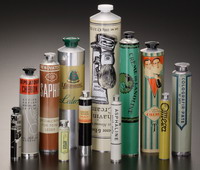A success story – the tube's history
More than 175 years ago, the American painter John Rand discovered a brilliant and practical invention: the tube! Today, even though it has undergone several changes, this timeless packaging solution remains in good shape – ready for future requirements.
John Goffe Rand was an ambitious artist with a continually recurring problem: his paint on the colour palette dried out during his work. While thinking about how to conserve his essential working material, he made a simple but effective invention. He bought several plates of lead and folded them to a tube with a round profile. After that, Rand attached a round orifice with a thread at one end of the tube, which completed his invention. His creation was squeezable, and it provided its user with exactly the amount of pasty content that he needed. Realising the great potential of his technological discovery, he wasted no time and applied for a patent on October 11, 1841. Although Rand was the owner of the first tube patent, other inventors tried their luck and developed their own designs. The most successful person to copy Rand’s idea (shortly after his invention, Rand moved to Europe to learn more about art) was the French artist Monsieur Richard. He produced tubes for oil paint, but used tin instead of lead.
Richard was very successful with his products, and he gave future generations of well-known artists such as Monet and Renoir the chance to expand their artwork to new dimensions.
The next important step in the history of the tube as we know it today was in the materials field. The variety of basic materials was expanded when Henry Sainte-Clair introduced a new material, aluminium, at the 1855 World Exhibition in Paris. Meanwhile, the development of machines and industrial processing marched on, until aluminium could be used to manufacture tubes. The first mass production in Pforzheim started in 1879. Tin and lead were still used.
Other industries discover tubes for their products
Beginning in 1886, attempts were made to fill aluminium tubes with contents other than paint. The first alternative content was toothpaste in 1887, following the invention of this long-needed chemical compound by F.A. Sarg in Vienna. Toothpaste was the ideal content for the packaging material tube; the growing demand for this pasty compound in Europe and America increased the need for tubes and manufacturing facilities. In the following decades, more and more products, both newly invented and well-known, found their way into the tube.
The first attempts to use aluminium for the industrial production of tubes came in 1913. The first year with a high production rate was 1920, and thereafter the number rose greatly during the 1920s and 30s. In 1939, the aluminium tube celebrated its victory over the other materials used up until then; today lead and tin are long forgotten materials for tube production.
After more than 175 years ago of history as a material for high-quality packaging, the aluminium tube is still a success story. Although it has undergone changes in technological and economical respects, it is still the most used tube in Europe. About 40 percent of all tubes sold are aluminium tubes.
All industries today, whether they produce pharmaceuticals, cosmetics, paint or pasty chemicals for technical use, rely on the aluminium tube as the premium packaging for their precious products, and they will continue to do so in the future.
